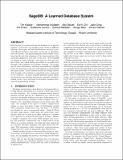Notice
This is not the latest version of this item. The latest version can be found at:https://dspace.mit.edu/handle/1721.1/132282.2
SageDB: A learned database system
Author(s)
Kraska, T; Alizadeh, M; Beutel, A; Chi, EH; Ding, J; Kristo, A; Leclerc, G; Madden, S; Mao, H; Nathan, V; ... Show more Show less
DownloadAccepted version (772.6Kb)
Open Access Policy
Open Access Policy
Creative Commons Attribution-Noncommercial-Share Alike
Terms of use
Metadata
Show full item recordAbstract
© 2019 Conference on Innovative Data Systems Research (CIDR). All rights reserved. Modern data processing systems are designed to be general purpose, in that they can handle a wide variety of different schemas, data types, and data distributions, and aim to provide efficient access to that data via the use of optimizers and cost models. This general purpose nature results in systems that do not take advantage of the characteristics of the particular application and data of the user. With SageDB we present a vision towards a new type of a data processing system, one which highly specializes to an application through code synthesis and machine learning. By modeling the data distribution, workload, and hardware, SageDB learns the structure of the data and optimal access methods and query plans. These learned models are deeply embedded, through code synthesis, in essentially every component of the database. As such, SageDB presents radical departure from the way database systems are currently developed, raising a host of new problems in databases, machine learning and programming systems.
Journal
CIDR 2019 - 9th Biennial Conference on Innovative Data Systems Research